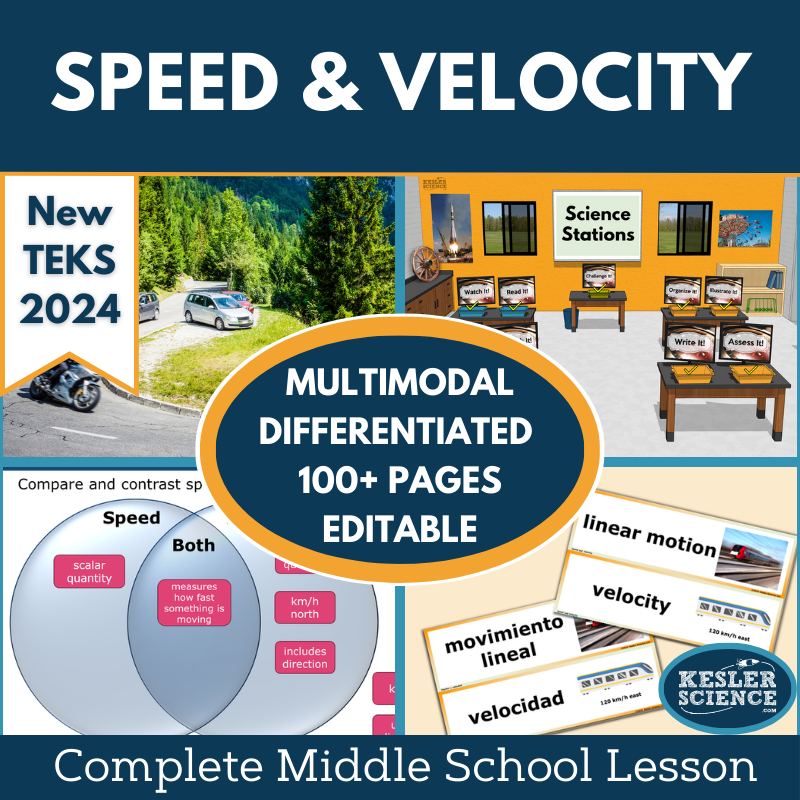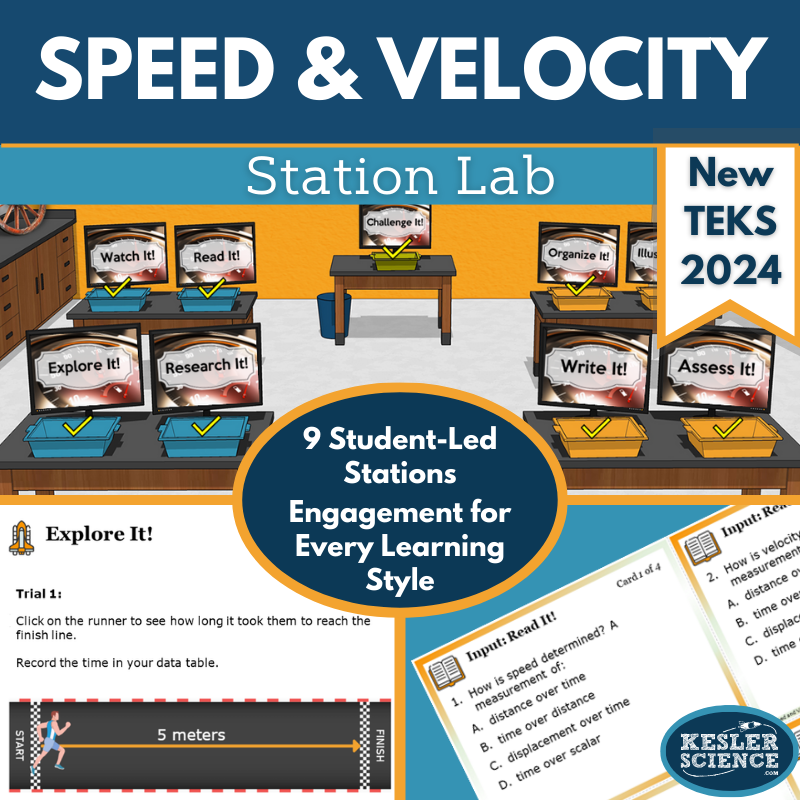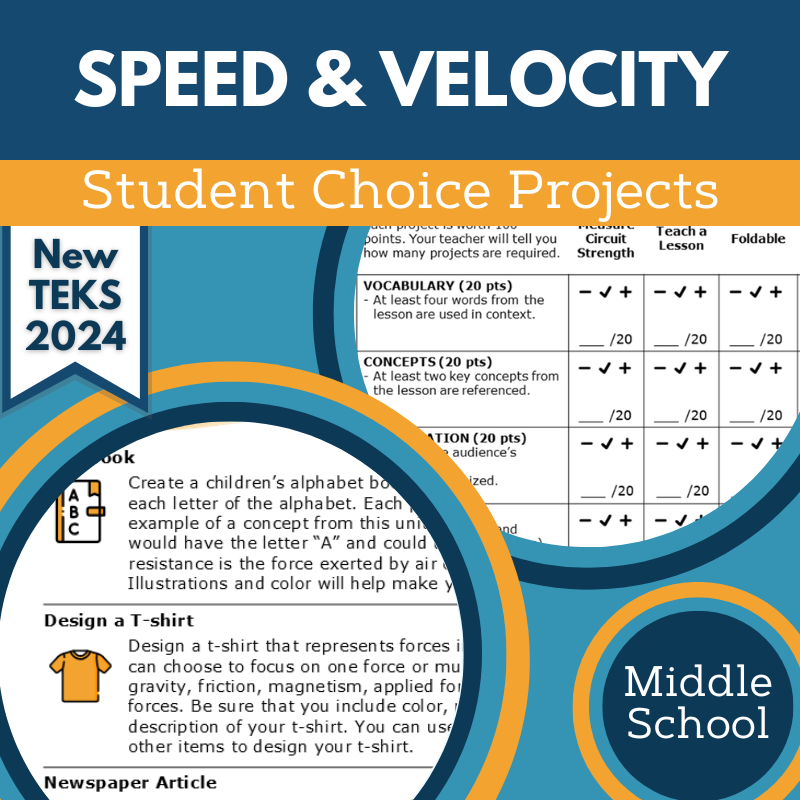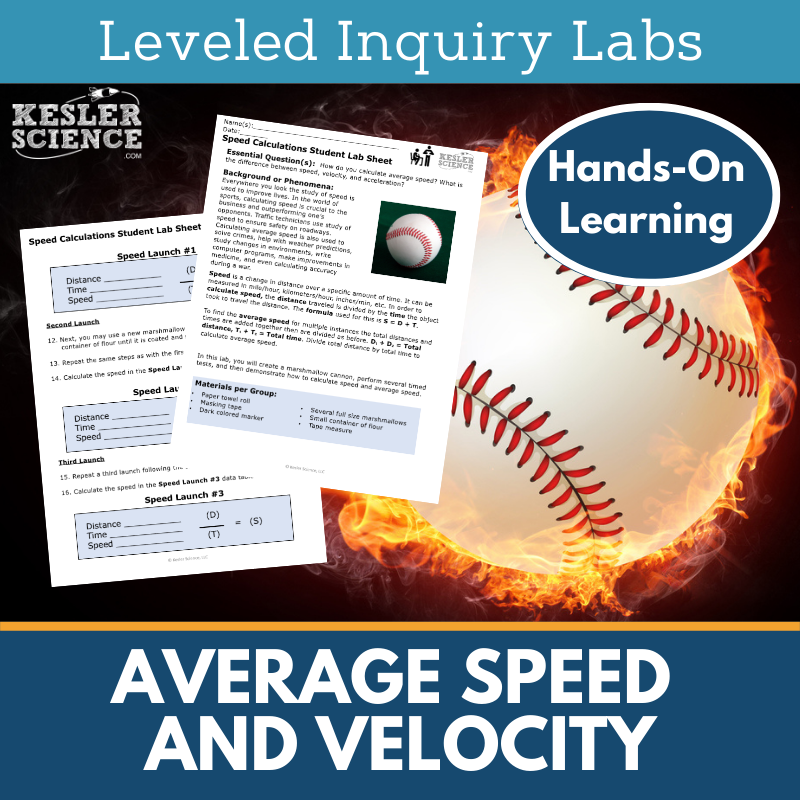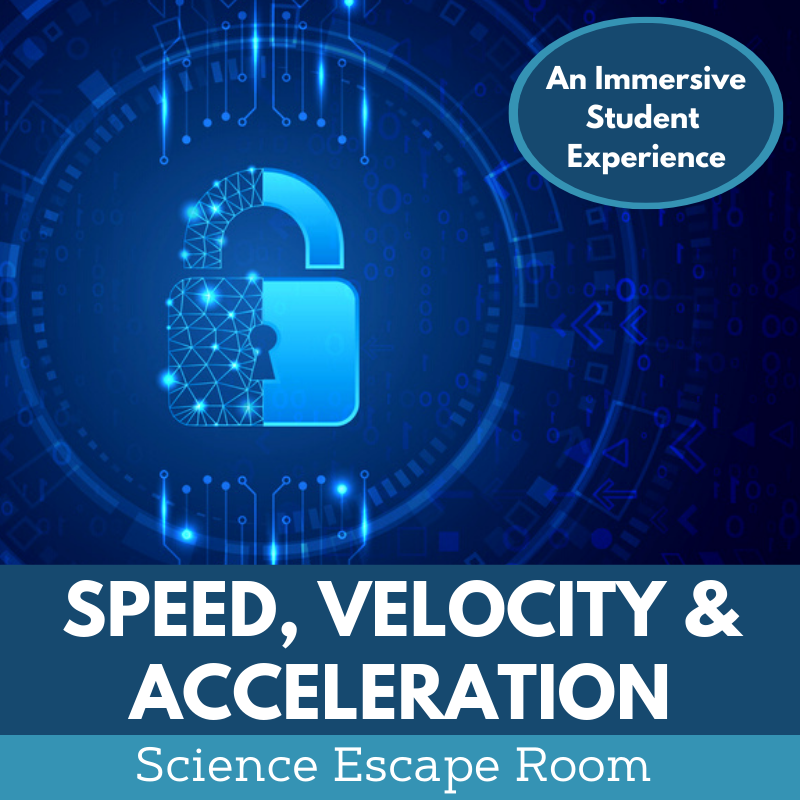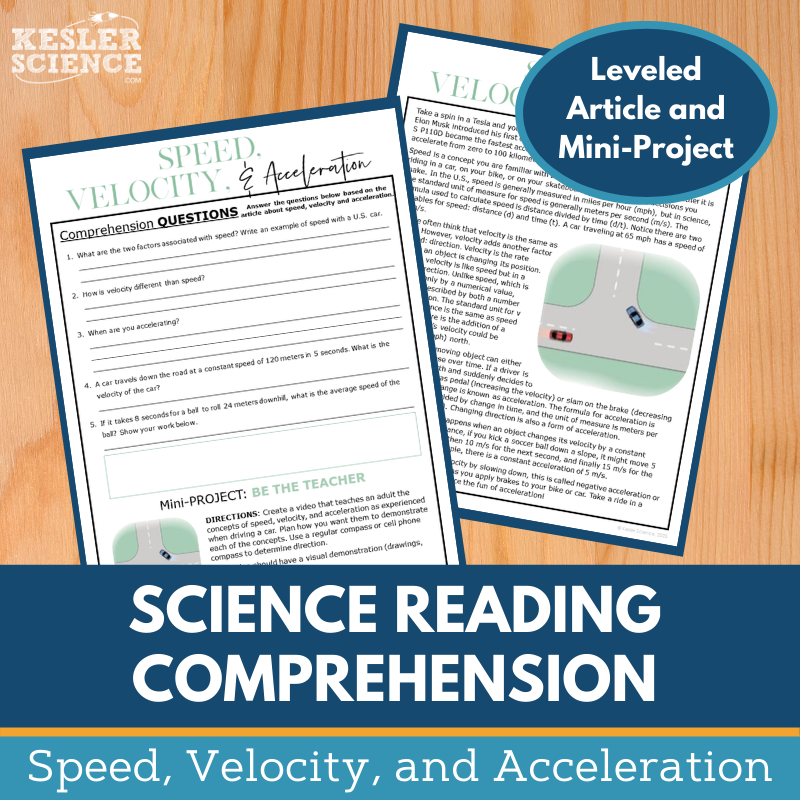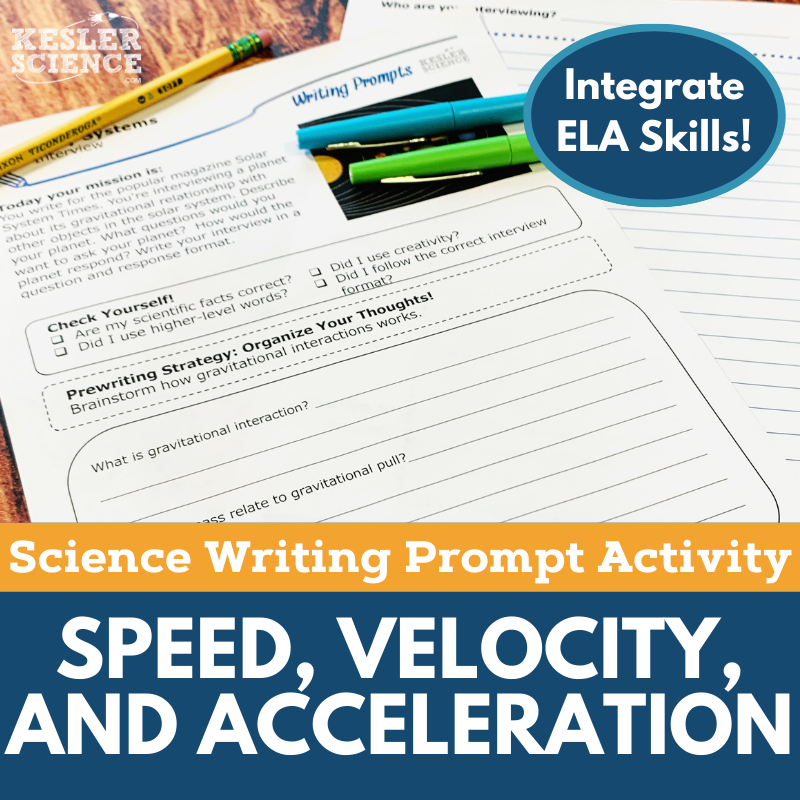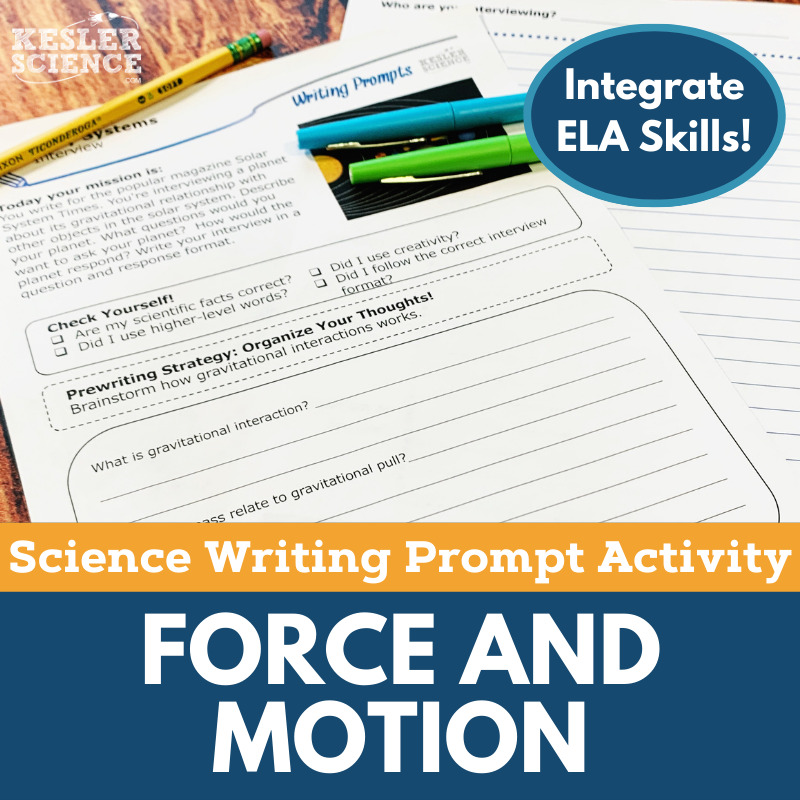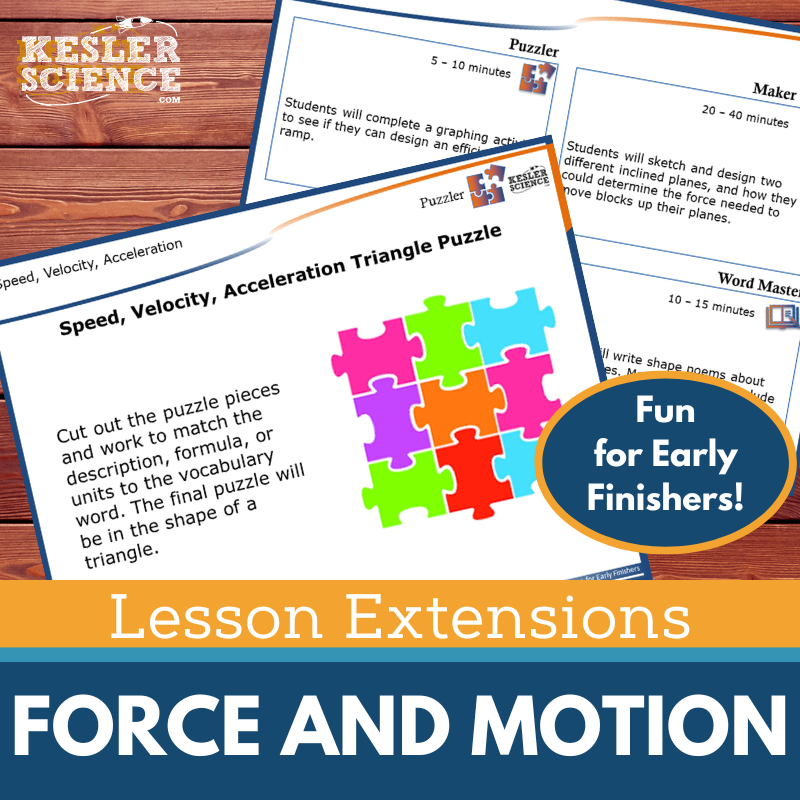Speed & Velocity Activities for Middle School Science
Help students distinguish between speed and velocity with this engaging 5E lesson aligned to TEKS 7.7B. The resources below will give students a comprehensive understanding of speed and velocity. All of the following materials are also included in the Kesler Science Membership.
The Kesler Science Speed & Velocity 5E Lesson engages middle school students in distinguishing between speed and velocity in terms of distance, displacement, and direction. It includes editable presentations, worksheets, choice projects, and assessments, designed for differentiated, student-led learning with low to no prep. The lesson aligns with the 2021 TEKS 7.7B standard and includes Spanish translations for key materials.
Following the 5E Model, the lesson begins with engagement activities, including vocabulary and class discussion prompts. In the exploration phase, a student-led station lab introduces concepts through multimodal input and output stations, offering hands-on experiments, readings, videos, research tasks, and creative responses. The explanation phase provides editable PowerPoints, interactive notebooks, and note-taking templates in multiple formats. For elaboration, student-choice projects extend learning on distance, displacement, and direction. Evaluation includes STAAR 2.0-aligned assessments, review questions, and worksheets for discussion or practice.
Designed for flexibility, this lesson is available in digital and printable formats, making it suitable for both in-class and virtual learning environments.
The Kesler Science Speed & Velocity 5E Lesson engages middle school students in distinguishing between speed and velocity in terms of distance, displacement, and direction. It includes editable presentations, worksheets, choice projects, and assessments, designed for differentiated, student-led learning with low to no prep. The lesson aligns with the 2021 TEKS 7.7B standard and includes Spanish translations for key materials.
Following the 5E Model, the lesson begins with engagement activities, including vocabulary and class discussion prompts. In the exploration phase, a student-led station lab introduces concepts through multimodal input and output stations, offering hands-on experiments, readings, videos, research tasks, and creative responses. The explanation phase provides editable PowerPoints, interactive notebooks, and note-taking templates in multiple formats. For elaboration, student-choice projects extend learning on distance, displacement, and direction. Evaluation includes STAAR 2.0-aligned assessments, review questions, and worksheets for discussion or practice.
Designed for flexibility, this lesson is available in digital and printable formats, making it suitable for both in-class and virtual learning environments.
Engage your students with this student-led station lab aligned with TEKS 7.7B, exploring speed and velocity through interactive, hands-on activities. Designed for in-class or virtual learning, this lesson helps students distinguish between speed and velocity in terms of distance, displacement, and direction while fostering independent learning.
Students engage with nine differentiated stations featuring videos, readings, research, and hands-on tasks. Input stations introduce concepts through exploration, video analysis, reading comprehension, and research, while output stations allow students to demonstrate learning through organization, illustration, writing, and assessment. A bonus challenge station provides extension activities for advanced learners. This low-prep, high-engagement resource promotes active learning and critical thinking.
Engage your students with this student-led station lab aligned with TEKS 7.7B, exploring speed and velocity through interactive, hands-on activities. Designed for in-class or virtual learning, this lesson helps students distinguish between speed and velocity in terms of distance, displacement, and direction while fostering independent learning.
Students engage with nine differentiated stations featuring videos, readings, research, and hands-on tasks. Input stations introduce concepts through exploration, video analysis, reading comprehension, and research, while output stations allow students to demonstrate learning through organization, illustration, writing, and assessment. A bonus challenge station provides extension activities for advanced learners. This low-prep, high-engagement resource promotes active learning and critical thinking.
The Speed & Velocity Student Choice Projects align with the 2021 TEKS standard 7.7B, giving middle school students the flexibility to choose a project that suits their preferred output style. A project page outlines six student-led options plus a “design your own” project, all with an editable rubric for teacher, peer, or self-assessment.
These multimodal projects offer creative ways for students to demonstrate their understanding. Two versions of the project page provide differentiation, with modified options for students needing remediation and challenge opportunities for advanced learners. Teachers can customize the rubric to fit grading needs.
The projects require standard classroom supplies like paper, markers, and scissors, with many options available for digital completion.
The Speed & Velocity Student Choice Projects align with the 2021 TEKS standard 7.7B, giving middle school students the flexibility to choose a project that suits their preferred output style. A project page outlines six student-led options plus a “design your own” project, all with an editable rubric for teacher, peer, or self-assessment.
These multimodal projects offer creative ways for students to demonstrate their understanding. Two versions of the project page provide differentiation, with modified options for students needing remediation and challenge opportunities for advanced learners. Teachers can customize the rubric to fit grading needs.
The projects require standard classroom supplies like paper, markers, and scissors, with many options available for digital completion
The Average Speed and Velocity Inquiry Lab aligns with TEKS, helping students differentiate between speed, velocity, and acceleration. In this hands-on investigation, students explore how the steepness of a ramp affects the speed of a toy car. They will measure distance and time, calculate speed, and create a distance-time graph of their results. The lab requires enough floor or desk space to set up a ramp and a 1-meter track.
This resource includes three differentiated lab versions to support all learners. The Dependent Student Lab provides a structured experience with procedural instructions and guided inquiry questions. The Modified Student Lab offers the most support, incorporating sentence stems and multiple-choice questions for students needing modifications. The Independent Student Lab allows advanced learners to take control of their investigations with minimal guidance.
Teacher resource pages include preparation details, standards, objectives, directions, materials, and additional resources. Editable reflection questions guide students in crafting Claim, Evidence, and Reasoning (CER) statements. Suggested answer keys simplify grading.
Materials needed per group include a toy car (Hot Wheels® or similar), a clipboard or wooden board, two textbooks, a meter stick, masking tape, two stopwatches, and colored pencils. This engaging lab provides an interactive way for students to deepen their understanding of motion concepts.
The Average Speed and Velocity Inquiry Lab aligns with TEKS, helping students differentiate between speed, velocity, and acceleration. In this hands-on investigation, students explore how the steepness of a ramp affects the speed of a toy car. They will measure distance and time, calculate speed, and create a distance-time graph of their results. The lab requires enough floor or desk space to set up a ramp and a 1-meter track.
This resource includes three differentiated lab versions to support all learners. The Dependent Student Lab provides a structured experience with procedural instructions and guided inquiry questions. The Modified Student Lab offers the most support, incorporating sentence stems and multiple-choice questions for students needing modifications. The Independent Student Lab allows advanced learners to take control of their investigations with minimal guidance.
Teacher resource pages include preparation details, standards, objectives, directions, materials, and additional resources. Editable reflection questions guide students in crafting Claim, Evidence, and Reasoning (CER) statements. Suggested answer keys simplify grading.
Materials needed per group include a toy car (Hot Wheels® or similar), a clipboard or wooden board, two textbooks, a meter stick, masking tape, two stopwatches, and colored pencils. This engaging lab provides an interactive way for students to deepen their understanding of motion concepts.
The Speed, Velocity, and Acceleration Escape Room is an engaging, student-centered activity designed to reinforce key motion concepts. Aligned with TEKS and NGSS standards, this escape room challenges students to apply their understanding of position, direction, speed, velocity, and acceleration through interactive puzzles.
Teachers have full control over the eight independent puzzles, allowing for customization based on class time and student needs. The escape room can be set up using manila envelopes or a more immersive lock-and-box format. A digital version is available for online learning via PowerPoint or Google Slides, with printable options for home use.
Included in this resource are teacher directions, answer keys, a digital answer sheet, and editable templates. Additional materials such as video challenges, printable props, prize ideas, and reward templates enhance the experience, ensuring an exciting and educational activity that will keep students engaged.
The Speed, Velocity, and Acceleration Escape Room is an engaging, student-centered activity designed to reinforce key motion concepts. Aligned with TEKS and NGSS standards, this escape room challenges students to apply their understanding of position, direction, speed, velocity, and acceleration through interactive puzzles.
Teachers have full control over the eight independent puzzles, allowing for customization based on class time and student needs. The escape room can be set up using manila envelopes or a more immersive lock-and-box format. A digital version is available for online learning via PowerPoint or Google Slides, with printable options for home use.
Included in this resource are teacher directions, answer keys, a digital answer sheet, and editable templates. Additional materials such as video challenges, printable props, prize ideas, and reward templates enhance the experience, ensuring an exciting and educational activity that will keep students engaged.
This Science Reading Comprehension Passage helps students explore the differences between speed, velocity, and acceleration through a nonfiction article, comprehension questions, and a video project. Designed for grades 6-8, the leveled passage supports science literacy and reading comprehension.
The resource includes two Lexile-leveled articles (1100-1300), five to seven comprehension questions, and a hands-on mini-project where students create a video demonstrating these concepts in the context of driving a car. A Cornell notes template is also provided.
Ideal for sub plans, ISS, extra credit, or whole-class instruction, this resource fosters critical thinking, classroom discussions, and textual analysis. It is compatible with virtual learning platforms such as Google Classroom, MS Teams, Schoology, and Canvas, allowing students to complete assignments digitally.
This Science Reading Comprehension Passage helps students explore the differences between speed, velocity, and acceleration through a nonfiction article, comprehension questions, and a video project. Designed for grades 6-8, the leveled passage supports science literacy and reading comprehension.
The resource includes two Lexile-leveled articles (1100-1300), five to seven comprehension questions, and a hands-on mini-project where students create a video demonstrating these concepts in the context of driving a car. A Cornell notes template is also provided.
Ideal for sub plans, ISS, extra credit, or whole-class instruction, this resource fosters critical thinking, classroom discussions, and textual analysis. It is compatible with virtual learning platforms such as Google Classroom, MS Teams, Schoology, and Canvas, allowing students to complete assignments digitally.
The Speed, Velocity, and Acceleration Science Writing Prompt Activity engages middle school students in a creative narrative exercise to reinforce their understanding of physical science concepts. Designed for TEKS, this activity helps students differentiate between speed, velocity, and acceleration while enhancing their science reasoning and writing skills. It is adaptable for both in-person and virtual learning.
This resource includes teacher directions with an answer guide, project ideas, and rubrics. It offers projection and print-ready handouts, including full-sized and half-sheet versions with prompts, student self-checks, and pre-writing strategies. A digital interactive version is also available in PowerPoint, easily converted to Google Slides for remote learning.
Ideal for cross-curricular activities, pre-test assessments, student choice projects, early finisher tasks, extra credit, make-up work, and differentiation, this writing prompt fosters engagement and comprehension. Students can showcase their work on a bulletin board or compile it into an anthology, making it a valuable addition to any science classroom.
The Speed, Velocity, and Acceleration Science Writing Prompt Activity engages middle school students in a creative narrative exercise to reinforce their understanding of physical science concepts. Designed for TEKS, this activity helps students differentiate between speed, velocity, and acceleration while enhancing their science reasoning and writing skills. It is adaptable for both in-person and virtual learning.
This resource includes teacher directions with an answer guide, project ideas, and rubrics. It offers projection and print-ready handouts, including full-sized and half-sheet versions with prompts, student self-checks, and pre-writing strategies. A digital interactive version is also available in PowerPoint, easily converted to Google Slides for remote learning.
Ideal for cross-curricular activities, pre-test assessments, student choice projects, early finisher tasks, extra credit, make-up work, and differentiation, this writing prompt fosters engagement and comprehension. Students can showcase their work on a bulletin board or compile it into an anthology, making it a valuable addition to any science classroom.
The The Force and Motion Science Writing Prompt Activity engages middle school students in a creative invention-based exercise to reinforce their understanding of velocity and acceleration. Aligned with TEKS, this activity enhances students' science reasoning and writing skills while supporting both in-person and virtual learning.
This resource includes teacher directions with an answer guide, project ideas, and rubrics. It provides projection and print-ready handouts, including full-sized and half-sheet versions with prompts, student self-checks, and pre-writing strategies. A digital interactive version in PowerPoint is also available, easily converted to Google Slides for remote learners.
Ideal for cross-curricular activities, pre-test assessments, student choice projects, early finisher tasks, extra credit, make-up work, and differentiation, this writing prompt fosters creativity and comprehension. Students can display their work on a bulletin board or compile it into an anthology, making it a valuable addition to any science classroom.
The The Force and Motion Science Writing Prompt Activity engages middle school students in a creative invention-based exercise to reinforce their understanding of velocity and acceleration. Aligned with TEKS, this activity enhances students' science reasoning and writing skills while supporting both in-person and virtual learning.
This resource includes teacher directions with an answer guide, project ideas, and rubrics. It provides projection and print-ready handouts, including full-sized and half-sheet versions with prompts, student self-checks, and pre-writing strategies. A digital interactive version in PowerPoint is also available, easily converted to Google Slides for remote learners.
Ideal for cross-curricular activities, pre-test assessments, student choice projects, early finisher tasks, extra credit, make-up work, and differentiation, this writing prompt fosters creativity and comprehension. Students can display their work on a bulletin board or compile it into an anthology, making it a valuable addition to any science classroom.
The WIKI Tickets© Formative Assessments provide engaging, flexible ways to check student understanding in 6th-8th grade science. The Force and Motion Set includes 14 topics, each with five format options: a full-screen projection version, three print handouts, and a digital interactive version compatible with PowerPoint and Google Slides.
Aligned with NGSS and TEKS standards, these assessments cover key topics such as calculating speed and unbalanced forces, graphing motion, gravity and mass, inclined planes, invisible forces, Newton’s laws, velocity, and acceleration. Each set includes a bonus table of contents file to show standard alignment.
These assessments can be used as exit tickets, bellringers, or quick checks in both in-person and virtual learning settings. Students can respond on paper, or in a 1:1 or remote setting, they can complete answers digitally. WIKI Tickets© provide a versatile, ready-to-use resource to assess student progress effectively.
The WIKI Tickets© Formative Assessments provide engaging, flexible ways to check student understanding in 6th-8th grade science. The Force and Motion Set includes 14 topics, each with five format options: a full-screen projection version, three print handouts, and a digital interactive version compatible with PowerPoint and Google Slides.
Aligned with NGSS and TEKS standards, these assessments cover key topics such as calculating speed and unbalanced forces, graphing motion, gravity and mass, inclined planes, invisible forces, Newton’s laws, velocity, and acceleration. Each set includes a bonus Table of Contents file to show standard alignment.
These assessments can be used as exit tickets, bellringers, or quick checks in both in-person and virtual learning settings. Students can respond on paper, or in a 1:1 or remote setting, they can complete answers digitally. WIKI Tickets© provide a versatile, ready-to-use resource to assess student progress effectively.
Lesson Extensions provide engaging, student-choice activities designed to challenge early finishers and deepen their understanding of force and motion concepts. These activities help fill downtime, reinforce critical thinking, and keep students engaged with rigorous yet enjoyable learning opportunities. Aligned to NGSS and TEKS standards, they offer high-level, independent learning and enrichment.
Each extension includes four interactive components: Puzzler for problem-solving, Maker Space for hands-on STEAM activities, Tech Connection for digital demonstrations, and Word Master for creative writing. With teacher directions, answer keys, and both print and projection versions, these extensions are perfect for lesson wrap-ups, enrichment, or independent challenges. Topics covered include Newton’s laws, motion and forces, speed and acceleration, gravity, and electromagnetic forces, ensuring students stay engaged while exploring key physics concepts.
Lesson Extensions provide engaging, student-choice activities designed to challenge early finishers and deepen their understanding of force and motion concepts. These activities help fill downtime, reinforce critical thinking, and keep students engaged with rigorous yet enjoyable learning opportunities. Aligned to NGSS and TEKS standards, they offer high-level, independent learning and enrichment.
Each extension includes four interactive components: Puzzler for problem-solving, Maker Space for hands-on STEAM activities, Tech Connection for digital demonstrations, and Word Master for creative writing. With teacher directions, answer keys, and both print and projection versions, these extensions are perfect for lesson wrap-ups, enrichment, or independent challenges. Topics covered include Newton’s laws, motion and forces, speed and acceleration, gravity, and electromagnetic forces, ensuring students stay engaged while exploring key physics concepts.
Year-Round Resources
These year-round activities will increase your students' understanding of many middle school science topics. All of these activities are also included in the Kesler Science Membership.
Visual Data & Graphing
You're not alone if your students struggle with understanding graphs, charts, and tables. It's a skill that takes an enormous amount of practice. This resource will help students build a strong foundation in analyzing data and creating their own data visualizations.
Bell Ringers and Warm-Ups
These middle school science bell ringers are an excellent way to engage your students as soon as they walk into your classroom. This comprehensive FULL YEAR resource includes everything you need to start off each science class with an interesting warm-up activity.
Review Board Games
Each game board has been carefully designed to keep students engaged. There are 10 different action spaces on each board and dozens of question cards. All of the actions are related to science concepts and keep the students motivated throughout the game.
Each game is ready to play. Simply print out the board and the cards and let the students enjoy reviewing nine different units.
Essential Questions and Standards
Below are the essential questions and standards associated with the lessons and activities included in the atoms unit. This topic is only one of more than 100 middle school science topics included in the Kesler Science Membership.
-
What is the difference between speed and velocity in terms of distance, displacement, and direction?
-
TEKS Science - 7.7B Speed & Velocity
Kesler Science Membership
Imagine never having to search for another middle school science lesson again. The membership gives you access to ALL of the Kesler Science products in one place (Yes, including everything above).
Say goodbye to long hours of lesson prep.

